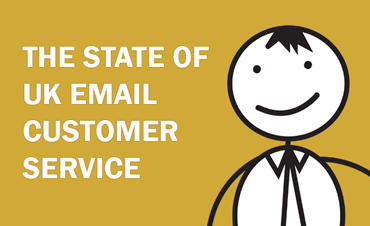The state of UK email customer service

In an era where social media, self-service and chat are being increasingly used for customer service, it is easy for organisations to overlook email or to not provide the channel with sufficient resources. Yet new research from analysts Contact Babel in The 2015 UK Contact Centre Decision-Maker’s Guide emphasise its importance while evaluating cost and time taken to answer – and how responding to customer interactions on this channel can be improved.
Email usage by sector
Contact Babel’s research, which was carried out with UK contact centre managers, found that email makes up an average of 17% of incoming queries from customers. However, this varies widely between sectors, from nearly a third of interactions in Retail & Distribution down to 6% in Transport and Travel:
- Retail & Distribution (30%)
- Manufacturing (28%)
- Services (20%)
- Insurance (18%)
- Technology, Media, Telecoms (TMT) (17%)
- Outsourcing (16%)
- Finance (15%)
- Housing (13%)
- Utilities (12%)
- Public Sector (11%)
- Transport & Travel (6%)
Interestingly, at 21.4% of interactions, smaller contact centres received more email than their larger counterparts, where the channel only represented 10% of their total volume. This demonstrates the vital importance of email to small and medium sized enterprises (SMEs). For these organisations, being able to answer email quickly and accurately can provide a competitive advantage against larger rivals, directly impacting revenues.
The cost of email
Based on its research, Contact Babel puts the average cost of answering an email at £2.67, lower than the telephone (£3.50-£4.00) but higher than web chat. This average does hide significant differences – it cost some companies £4.10 to respond to an email, while others were able to reply at a rate of £1.30 per message.
The differences can be explained by a number of factors, including:
- Many organisations still answer email through standard desktop applications, rather than investing in specialist customer service software. This pushes up handling times, makes it difficult to track interactions and consequently increases costs.
- Over half (56%) of emails are answered manually by agents, who draft every response from scratch (rather than accessing a set of templates or editing an automatic reply generated by a knowledge base).
- If customers fail to receive a fast response, they may well email again – or even move to the more expensive voice channel. Just 12% of emails were answered within an hour, with 47% taking between 1-24 hours according to Contact Babel. Given that over half (56%) of Britons want a response within 4 hours, this lack of speed will damage the overall customer experience too.
Increasing email efficiency
The potential cost of answering email for a medium sized organisation can be enormous. Take a retailer that receives an average of 100 emails a day. At £2.67 to respond to each one, the overall cost is over £97,100 – a significant amount of resources. And, if they are answered badly or slowly, angry customers will simply take their business elsewhere, hurting revenues as well as pushing up costs. Bringing the cost down to the lower figure of £1.30 per message will more than halve the budget required to £47,000.
So how can organisations increase the efficiency of email? As part of Eptica’s sponsorship of the email management chapter of the Contact Babel UK Contact Centre Decision-Maker’s Guide 2015, we’ve set out 5 areas where organisations can focus if they want to reduce costs, while still delivering a superior experience:
1. Deflect what you can
Minimise the number of unnecessary emails you get by ensuring that routine information is available online, such as through web self-service systems. This will improve customer satisfaction (as they don’t need to wait to find an answer), as well as increasing efficiency.
2. Automate the workflow
Instead of simply collecting all incoming emails into a single queue and then passing them to agents one by one, use intelligence to route them to the best available employee to provide a fast answer. By analysing incoming interactions and looking at factors such as language, type of product and even sentiment, they can be prioritised and passed to the agent with the best skills.
3. Provide a consistent response
The majority of email responses are created individually, by hand, by individual agents. Not only does this lower productivity but it also breeds inconsistency. Create a centralised knowledge basethat contains approved information for agents to use and build templates that are automatically suggested dependent on the query. This speeds up response times while still allowing agents to personalise each email to the needs of the individual customer.
4. Manage the process
Desktop email systems are likely to be insufficiently powerful for organisations receiving over 100 emails a day. For that reason, consider putting in place an end-to-end platform with in-built workflow to replace desktop email if you want to take back control of the process and improve service levels.
5. Set targets – and stick to them
As with every channel, customer expectations are rising continually. Make sure that you set targets for response times and communicate them to customers. Be realistic when setting expectations, but at the same time be sure that they are not too long as to be meaningless to your customers.
The full email findings of the Contact Babel UK Contact Centre Decision-Maker’s Guide 2015, can be downloaded from http://www.eptica.com/2015-uk-contact-centre-decision-makers-guide-email-management-chapter-0. If you would like to discuss any of the findings or schedule a demo of Eptica’s multichannel customer interaction management software, please don’t hesitate to contact us.







Comments